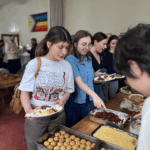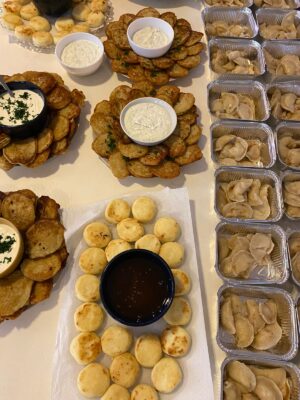


Varenyky, syrnyky and deruny served at RPM's Ukrainian Culture Café
By Olianna Dimitropoulou and Alaïa Lafleur
During Refugee Project Maastricht’s Ukrainian Culture Café, a group of Ukrainian volunteers, headed by Vasylyna Saievych, prepared a variety of Ukrainian dishes for more than 80 participants. Afterward, RPM had the pleasure of sitting down with the talented Vasylyna for an interview, with translation assistance from Iryna Busol, who also generously shared the varenyky recipe below.
Do you cook often? Which was your favorite dish to cook for the Ukrainian Culture Café?
“We cook every day. There is even a joke that Ukrainian women cook food for entire festivals. Besides, Vasylyna works in a restaurant so she cooks every day. And, her most favorite dish of all [from this event] is Syrnyky.”
How are all these dishes here pronounced?
“The soup is borsch(t)” (*Emphasis on the ssch*)
“Varenyky” (Vuh-rreh-ne-ke)
“Deruny” (Dhe-roun-ay)
“Syrnyky” (Surh-ne-ky)
Do people often get it wrong?
“Yes (laughs).”
So, you work in a restaurant. What does cooking mean to you?
“Generally speaking, the motto for Vasylyna is to cook delicious food for people and for people to realize how special Ukrainian food is. It’s very important for her to make people happy and more kind. And while cooking, the most important ingredients are love and to be in a good mood.”
So, then, do you feel like you don’t cook as well when you’re not in a good mood?
“(Laughs heartily). The main thing is to first be in a good mood, and she has to be hungry.”
Why did you chose these specific dishes to cook today?
“Because these dishes go back to ancient times, to Kyivan Rus’. People cooked these dishes many many years ago: our grannies, our moms. There are a huge amount of recipes for borscht, for example. So, these dishes best present Ukrainian tradition. And of course, Vasylyna has her own recipes for these dishes. But the core is the same.”
How many variations of these dishes are there? Which is the best one?
“So, Borscht and Varenyky [are the most representative Ukrainian dishes]: In Ukrainian cuisine, we say there are 52 variants of Borscht, (one for each day of the year). In fact, Borscht is a registered UNESCO Ukrainian heritage dish. And there are various recipes for Varenyky. First, the dough. It can be made with or without eggs, with boiled water, milk or kefir. As for stuffing, you can cook with stewed cabbage, mushrooms, meat, they can be meat, with cottage cheese, cherries. Varenyky with cherries and honey, it’s so delicious. We can’t count how many variations.”
On what occasions do you make these dishes? Are they special days, or just for every day?
“As for traditions, yes, they are everyday foods. Vasylyna says it depends on her mood, but frankly speaking, she can eat Borscht every day, three times a day (laughs). Borscht is an ordinary, common dish. Varenyky as well. But, Syrnyky is our favorite. Usually, because it takes time, women make it on the weekends. As for me, I made it with my husband together on weekends.
And in Ukrainian cuisine, there are hundreds of delicious dishes that aren’t very expensive. You can cook with everything you have in your fridge. Like in Three Men in a Boat. They cooked with everything they had. [There is, for example,] a very healthy dish, a soup without any spices. No spices at all, even without salt. It’s a special kind of soup with vegetables; that’s what gives taste to the food.”
Where do you usually get these ingredients from?
“In supermarkets. And, there also is a Turkish market where we can buy vegetables. We [Ukrainians] like herbs: parsley, dill, basil, etc. Yeah, there is no one place to buy produce. Just the nearest place (laughs).”
What do you associate with these dishes? What does it remind you of?
“You know, we have these dishes every day. They are so common for us. Ukrainian women cook Syrnyky in the morning, for example for their kids. It’s a nice food for starting a day. Borscht is usually cooked in the middle of the day as Ukrainian people prefer to have something liquid for lunch. It’s common. Our great grannies, our mothers, our great grandmother’s grandmothers used to eat these. It’s like, to breathe.”
How do you like the food where you live now?
“She likes only food she cooks herself.”
Thank you so much for granting us your time. Do you have any last words or a final message you would like to share with our readers?
“Delicious food makes people happier, more friendly and helps people to come together. That’s why it is very important.”
INGREDIENTS
(Yields approximately 30 dumplings).
For the dough:
For the filling:
Toppings:
INSTRUCTIONS
“There are many variants of dough recipes, but I will tell you about the one which is very cheap and simple.” – Iryna Busol
INGREDIENTS
(Yields approximately 16 pancakes).
Toppings:
INSTRUCTIONS